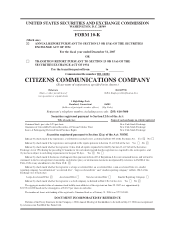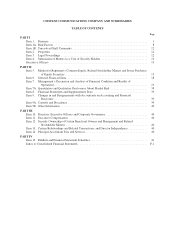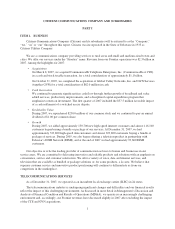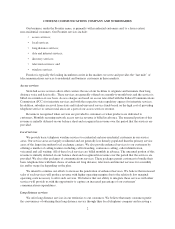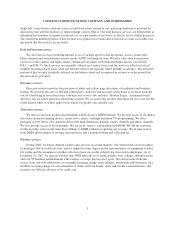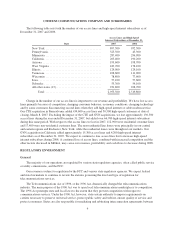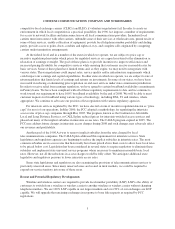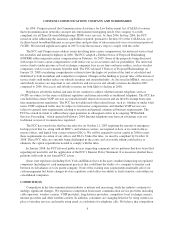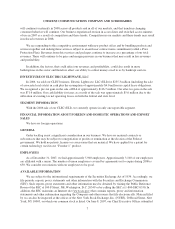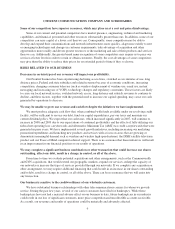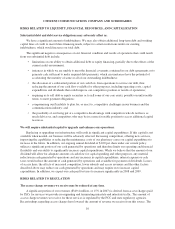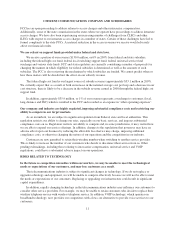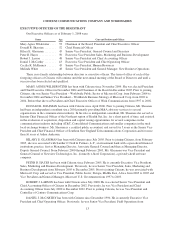Frontier Communications 2007 Annual Report Download - page 8
Download and view the complete annual report
Please find page 8 of the 2007 Frontier Communications annual report below. You can navigate through the pages in the report by either clicking on the pages listed below, or by using the keyword search tool below to find specific information within the annual report.
CITIZENS COMMUNICATIONS COMPANY AND SUBSIDIARIES
The following table sets forth the number of our access lines and high-speed internet subscribers as of
December 31, 2007 and 2006.
Access Lines and High-Speed
Internet Subscribers at December 31,
State 2007 2006
New York ...................................... 897,300 952,500
Pennsylvania .................................... 523,500 45,300
Minnesota ...................................... 287,400 296,900
California....................................... 205,400 190,200
Arizona ........................................ 199,600 198,700
West Virginia ................................... 183,700 178,100
Illinois ......................................... 129,000 129,100
Tennessee ...................................... 108,600 111,000
Wisconsin ...................................... 78,800 77,600
Iowa........................................... 57,100 57,600
Nebraska ....................................... 53,300 54,100
All other states (13)............................... 231,800 228,700
Total ...................................... 2,955,500 2,519,800
Change in the number of our access lines is important to our revenue and profitability. We have lost access
lines primarily because of competition, changing consumer behavior, economic conditions, changing technology
and by some customers disconnecting second lines when they add high-speed internet or cable modem service.
Our CTE acquisition in Pennsylvania added 434,600 access lines and 50,500 high-speed customers at date of
closing, March 8, 2007. Excluding the impact of the CTE and GVN acquisitions, we lost approximately 130,300
access lines during the year ended December 31, 2007, but added over 66,700 high-speed internet subscribers
during this same period. With respect to the access lines we lost in 2007, 112,900 were residential customer lines
and 17,400 were non-residential customer lines. The non-residential line losses were principally in our central
and eastern regions and Rochester, New York, while the residential losses were throughout our markets. Our
GVN acquisition in California added approximately 15,300 access lines and 4,200 high-speed internet
subscribers as of December 31, 2007. We expect to continue to lose access lines but to increase high-speed
internet subscribers during 2008. A continued loss of access lines, combined with increased competition and the
other factors discussed in MD&A, may cause our revenues, profitability and cash flows to decrease during 2008.
REGULATORY ENVIRONMENT
General
The majority of our operations are regulated by various state regulatory agencies, often called public service
or utility commissions, and the FCC.
Our revenue is subject to regulation by the FCC and various state regulatory agencies. We expect federal
and state lawmakers to continue to review the statutes governing the level and type of regulation for
telecommunications services.
The Telecommunications Act of 1996, or the 1996 Act, dramatically changed the telecommunications
industry. The main purpose of the 1996 Act was to open local telecommunications marketplaces to competition.
The 1996 Act preempts state and local laws to the extent that they prevent competition with respect to
communications services. Under the 1996 Act, however, states retain authority to impose requirements on
carriers necessary to preserve universal service, protect public safety and welfare, ensure quality of service and
protect consumers. States are also responsible for mediating and arbitrating interconnection agreements between
4



